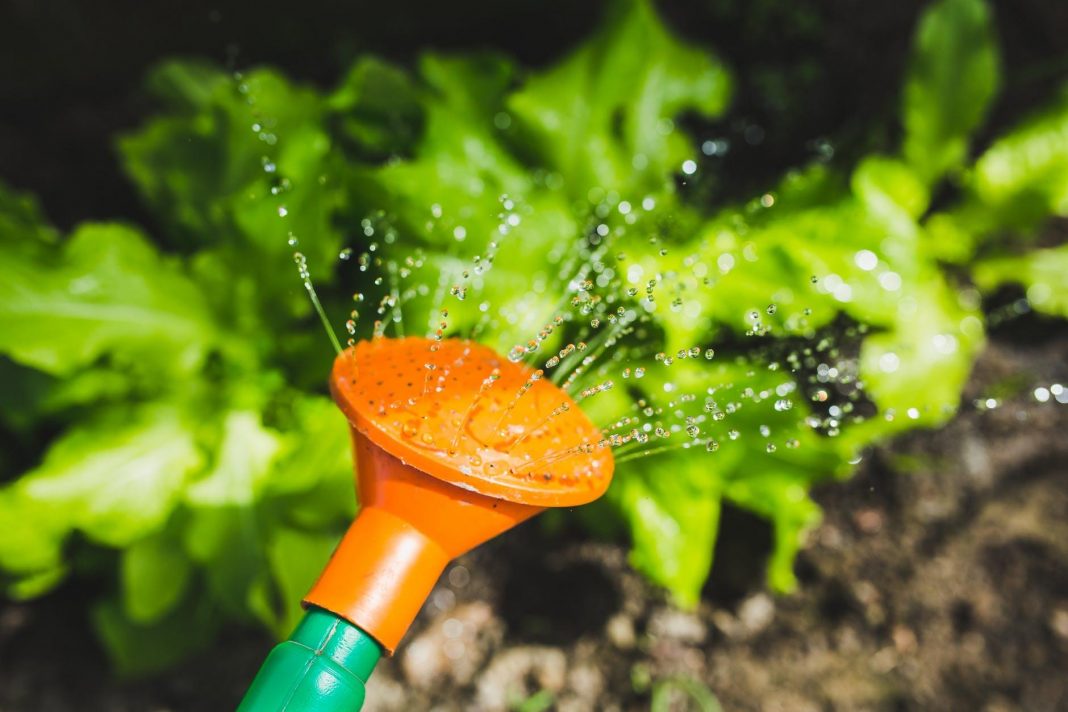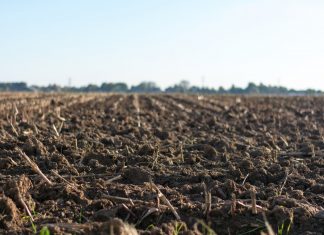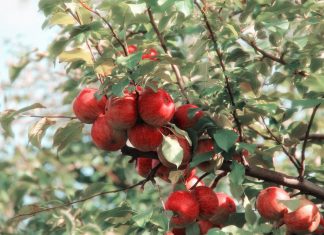 |
|
| Issue #74 • March/April, 2002 |
Are you tired of raising a big row crop gardenone that keeps you busy from dawn until dusk? Do you really need to raise enough vegetables to feed Cox’s army? At the end of the gardening season, are your freezer and pantry so well stocked that they are overstocked? If your answer is “Yes” to these questions, you might like to consider changing from row crop to raised bed gardening.
With raised bed gardening we avid gardeners can still enjoy harvesting plenty of fresh produce, but on a smaller scale than with a row crop garden. As we grow older and less inclined to take on the challenges of a large garden, we all begin to cast about for an easier way to do things. For that matter, it’s not always the elderly who want smaller gardens.
  Our raised beds produce an ample harvest and make it possible to keep our garden in a neater fashion than when we had the garden in row crop style. We still rotate plants each year just as we did with the rows. Our raised beds produce an ample harvest and make it possible to keep our garden in a neater fashion than when we had the garden in row crop style. We still rotate plants each year just as we did with the rows. |
Younger gardeners with families to rear and pressed for time to devote to family outings and Little League Baseball may benefit from a close-to-home projecti.e., raised bed gardening. Children introduced to gardening at an early age learn patience, responsibility, and the value of growing nutritious food. A good way to begin teaching them is to give each child a raised bed of his/her own. Some may want to grow flowers and vegetables and others may lean toward raising only their favorite vegetables. Whatever the choice, be supportive all the while passing along bits of information about the soil, when to plant or transplant, use of compost, when to water, etc. Highlight meals with something from a child’s own raised bed.
Converting from rows to raised beds may be done gradually. Nowhere is it written that this has to be done all at once or that it has to be done at any particular time of year. Fall is probably the most practical season to begin the changeover, as that is the time to clear the garden of old plants, pull down vine supports and generally tidy up the place. With a clean garden, one can measure and decide just how many raised beds are desirable, space needed between beds, and so forth.
Our raised beds are 4 x 8 feet in size as this is a comfortable working size for us. This allows for two rows of large plants such as peppers and tomatoes. Lower growing plantsturnips, bush beans, beetsmay be planted closer together making three rows per bed. We generally broadcast (scatter) seeds of lettuce, radishes, and mustard. The rectangular beds are lined up compass fashionshort sides toward north and south and long sides facing east and west. There is no set size for raised beds. You may prefer square beds or long narrow beds depending on space available. Just remember to construct them to suit your needs.
Tall growing vines (pole beans, cucumbers, etc.) are usually planted in a row along the west side of our beds so they will give some shade relief to shorter plants on the east side of the beds during hot summers. Climbing plants may also be planted A-frame fashion in the beds, leaving the ends open so one may easily slip in and harvest from the middle if desired. We prefer a straight line of hog wire secured by a post at each end and one in the middle. (We went to the stout support when we had trouble with bean vines blowing over during windstorms. There’s nothing like trying to straighten up heavy, snarled bean vines!)
When laying out the raised bed plans, allow plenty of room to use a mower between the beds if you are not going to put down bark or some other type of weed inhibitor. If you have a garden cart or other garden aid, you will want to have room enough to maneuver it easily. All of us need space to use kneeler/seats (you can get them from Pinetree Garden Seeds) or some type of low bench when we sit in the aisles to weed or cultivate.
We have used landscape timbers to outline our beds. Timbers are available at most large garden suppliers or lumberyards and come in 8-foot lengths. Cutting one in half gives the necessary 4-foot ends for a bed. (See illustration.) If landscape timbers are not available, there are lots of other materials to useconcrete blocks, bricks, old fence posts, etc.just so long as the material is compatible with the soil. You wouldn’t want to use something like newly creosoted railroad ties that would contaminate the soil. Old railroad ties that have had the creosote leached from them by long-time use are all right and will last for years.
  A raised bed of spring lettuce and radishes will produce all that we can use and still have some left for friends. |
Avoid making the sides of the beds so high and tight that you create a water trap. Everyone’s garden is a little different. Some are on slopes. Some are level. Some have boggy spots. Whatever the situation, the basics necessary for a successful garden still applygood drainage, plenty of sunshine, fertile soil, and water when necessary.
Raised beds are a dandy way to keep compost where it’s needed, as they prevent good soil from sliding away. If you want to let some beds lie idle during the gardening season, you can dump your organic gleanings in them and let nature take its course. Grass clippings, spent plants, wilted flowers, kitchen scraps (no grease or meat) will decompose just as they would in a compost pile. However, don’t dump any diseased plants or weeds loaded with seeds, as these can come back to haunt you later.
I can guarantee plenty of earthworms will show up to till the soil and give it the benefit of their castings. When you are ready to dig the decomposing matter into the soil and use the fallow beds, you will find that the soil is loose and easy to work with a garden spade or fork. While watering the rest of your garden during dry spells, don’t forget to give the fallow beds some water to keep them reasonably moist. Dried-out leaves, etc., don’t turn into compost very quickly and earthworms will die out or seek a better home if moisture is absent.
We let grass and white clover grow between our beds, thus eliminating the dust or mud we experienced underfoot when our garden was in rows. Low growing herbs such as pennyroyal (perennial, available from Pinetree Garden Seeds, Box 300, New Gloucester, ME 04260) spread out here and there in the aisles give off a delightful scent when stepped upon. With vegetation between the beds, the garden seems cooler during hot weather and we walk on a soft carpet.
Soil building is an important part of any garden and it’s much easier to control that aspect of gardening with raised beds. The constant adding of organic matter, whether it is compost or mulch, assures a continued supply of nutrients to the beds. The mulch used in summer to conserve moisture breaks down to form humus just as grass clippings, leaves, etc., decompose in a compost pile. I am often amazed at the loose, friable condition of our soil after a summer of mulching.
Even with the soil looking great, there is the possibility of the pH scale being out of balance. Briefly, pH is the measure of acidity or alkalinity of any substance, and where gardens are concerned pH is very important. The pH scale runs from 0 to 14. The greatest degree of acidity is 0, 7 is neutral, and 14 indicates the greatest degree of alkalinity. Most vegetable plants grow well in a soil that has a pH of 6.0-8.0. Lima beans prefer pH 5.5-6.5 and potatoes 4.8-6.5 making them slightly more acid loving. If you are uncertain as to the pH of your soil and you suspect the pH could be a little off one way or the other, it would be well to contact your county extension agent regarding a soil test. You may need to add a little lime to raise the pH or you may need to add sulfur to bring it down to neutral.
 There’s nothing better than fresh potatoes, and a sizable quantity can be had from a 4 x 8 foot raised bed. |
When ready to put in transplants, remember that plants are going to require about the same room as when grown in rows. In other words, don’t try to squeeze more sweet pepper plants into the beds than normal spacing would allow. Consider whether the pepper plants are tall growing or compact and bushy. Spacing can range from 10-15 inches apart depending on the varieties. Hot peppers also come in a variety of sizes from tall to short ornamental types. We use tomato cages as supports for all pepper plants, unless they are short growing and need no support. We place the cages over the young plants as soon as they are transplanted. Cages also serve as protection against prowling animals.
Tomato plants mature to different heights, too. Barring disease or disaster, tall vining or indeterminate varieties will continue to grow and produce until frost takes its toll. These varieties need plenty of spacing between plants, but it is still possible to have two rows of plants in the same bed OR to have a row of tomatoes on the west side of the bed and shorter plants on the east side.
Indeterminate tomatoes need tall, stout supports. We have a supply of tall cages made from reinforcing wire and, when necessary, we use bamboo canes horizontally between them. Tomato plants will often develop side shoots or suckers and become bushy. Each of these side shoots will bear flowers and fruit and, if left on the plants, they will require more and more of the plant’s energy resulting in smaller tomatoes or none at all. In our area plants need plenty of foliage to protect fruit from sun damage, but good ventilation between plants is also necessary. Therefore we clip out a number of suckers keeping in mind that plants still need to retain enough foliage to shade their fruit. Indeterminate plants growing in raised beds present a neat appearance when pruned and are easily accessible from all sides for mulching and weeding.
Determinate (fixed height) tomato plants usually give a good return, but due to their growth habit, once their fruit is set, that’s it. The tomatoes ripen, are harvested, and the vines produce little, if any, tomatoes after that. Our favorite determinate is Celebrity. It has good disease resistance and gives us an ample harvest. Being smaller plants than indeterminates, we can plant a couple more plants per bed and we can stake the plants with medium height tomato cages. After the spent plants are removed, we let the bed lie fallow until we put in a fall crop of greens or onions.
| Raised bed construction
We use landscape timbers around our raised beds. The depth of two horizontal timbers works for us, but some folks might only want one and others might even go to three. As time goes on, soil will build up around the bottom layer. Timbers are about 4 inches in diameter and we use 6-inch nails to keep them stationary. (Illustration, James 0. Yeager) |
Almost all southern gardens will have okra in them. Okra’s large shady leaves rule out planting anything else in the bed, so we devote a bed to a dwarf type okra such as Lee (Park Seed, 1 Parkton Ave., Greenwood, SC 29647-0001). We can have two rows of Lee plants spaced about 15 inches apart and staggered. Tall growing Clemson Spineless okra would be limited to about four or five plants per bed. Lee gives a prolific harvestplenty of pods to enjoy fresh and plenty to put in the freezer.
We don’t try to grow large rambling plantspumpkins, cushaws, etc., as it’s easier to buy the one fruit we’ll probably use than take up needed space to grow it. However, bush varieties have been developed that take up less space, so we may have the pleasure of trying some of those at a later date. Sweet potatoes need room to spread out, so they’re a no-no. However, a nice amount of Irish potatoes may easily be grown in a raised bed and the bed used for something else after the potatoes are dug.
As with almost any summer season there will be times when you wonder if you’ll ever see rain again. Beds have been well mulched, but plants look like they could benefit from a good soil soaking. It’s well to give Nature a hand by scheduling a watering patternmaybe twice per week or more often when the weather becomes downright hot and miserable. Raised bed gardening is a great way to conserve water, as the water put in the beds stays there and soaks in. We have a small inexpensive sprinkler that we turn on low pressure and place in our beds while we’re harvesting or working in the garden. This allows for a good soaking with no run-off and we don’t have to hover with hose in hand.
A fringe benefit of raised bed gardening is the amount of tools needed. No longer are garden tractors, tillers, and other large pieces of gardening equipment necessary. Once you have the soil in your beds in good humusy shape, you can get along with a spade, fork, and some small hand tools. Again, you will be the judge as to which tools work best for you.
We don’t use chemical fertilizers as that is one sure way to eliminate the earthworm and kill out beneficial microorganisms. Some gardeners have actually damaged their soil by the use of too many concentrated chemical fertilizers. Restoring the soil to good condition may take years. We have found compost and mulch seem to work best in our raised beds. After all, Mother Nature has been piling on the humus for a long time and it works for her. Just witness some of her prize-winning displays!














